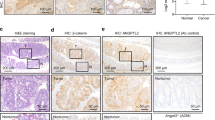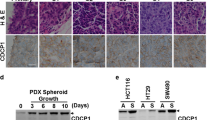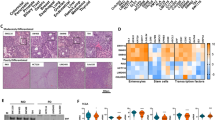Abstract
The genes encoding tyrosine kinase receptors EphB2 and EphB3 are β-catenin and Tcf4 target genes in colorectal cancer (CRC) and in normal intestinal cells1,2. In the intestinal epithelium, EphB signaling controls the positioning of cell types along the crypt-villus axis1. In CRC, EphB activity suppresses tumor progression beyond the earliest stages3,4. Here we show that EphB receptors compartmentalize the expansion of CRC cells through a mechanism dependent on E-cadherin–mediated adhesion. We demonstrate that EphB-mediated compartmentalization restricts the spreading of EphB-expressing tumor cells into ephrin-B1–positive territories in vitro and in vivo. Our results indicate that CRC cells must silence EphB expression to avoid repulsive interactions imposed by normal ephrin-B1–expressing intestinal cells at the onset of tumorigenesis.
This is a preview of subscription content, access via your institution
Access options
Subscribe to this journal
Receive 12 print issues and online access
$209.00 per year
only $17.42 per issue
Buy this article
- Purchase on Springer Link
- Instant access to full article PDF
Prices may be subject to local taxes which are calculated during checkout






Similar content being viewed by others
References
Batlle, E. et al. Beta-catenin and TCF mediate cell positioning in the intestinal epithelium by controlling the expression of EphB/ephrin-B. Cell 111, 251–263 (2002).
van de Wetering, M. et al. The beta-catenin/TCF-4 complex imposes a crypt progenitor phenotype on colorectal cancer cells. Cell 111, 241–250 (2002).
Batlle, E. et al. EphB receptor activity suppresses colorectal cancer progression. Nature 435, 1126–1130 (2005).
Clevers, H. & Batlle, E. EphB/Ephrin-B receptors and Wnt signaling in colorectal cancer. Cancer Res. 66, 2–5 (2006).
Huusko, P. et al. Nonsense-mediated decay microarray analysis identifies mutations of EPHB2 in human prostate cancer. Nat. Genet. 36, 979–983 (2004).
Noren, N.K., Foos, G., Hauser, C.A. & Pasquale, E.B. The EphB4 receptor suppresses breast cancer cell tumorigenicity through an Abl-Crk pathway. Nat. Cell Biol. 8, 815–825 (2006).
Guo, D.L. et al. Reduced expression of EphB2 that parallels invasion and metastasis in colorectal tumours. Carcinogenesis 27, 454–464 (2006).
Jubb, A.M. et al. EphB2 is a prognostic factor in colorectal cancer. Clin. Cancer Res. 11, 5181–5187 (2005).
Lugli, A. et al. EphB2 expression across 138 human tumor types in a tissue microarray: high levels of expression in gastrointestinal cancers. Clin. Cancer Res. 11, 6450–6458 (2005).
Taketo, M.M. Mouse models of gastrointestinal tumors. Cancer Sci. 97, 355–361 (2006).
Yamada, Y. et al. Microadenomatous lesions involving loss of Apc heterozygosity in the colon of adult Apc(Min/+) mice. Cancer Res. 62, 6367–6370 (2002).
Oshima, H., Oshima, M., Kobayashi, M., Tsutsumi, M. & Taketo, M.M. Morphological and molecular processes of polyp formation in Apc(delta716) knockout mice. Cancer Res. 57, 1644–1649 (1997).
Shih, I.M. et al. Top-down morphogenesis of colorectal tumors. Proc. Natl. Acad. Sci. USA 98, 2640–2645 (2001).
Davy, A., Aubin, J. & Soriano, P. Ephrin-B1 forward and reverse signaling are required during mouse development. Genes Dev. 18, 572–583 (2004).
el Marjou, F. et al. Tissue-specific and inducible Cre-mediated recombination in the gut epithelium. Genesis 39, 186–193 (2004).
Mellitzer, G., Xu, Q. & Wilkinson, D.G. Eph receptors and ephrins restrict cell intermingling and communication. Nature 400, 77–81 (1999).
Xu, Q., Mellitzer, G., Robinson, V. & Wilkinson, D.G. In vivo cell sorting in complementary segmental domains mediated by Eph receptors and ephrins. Nature 399, 267–271 (1999).
Fuller, T., Korff, T., Kilian, A., Dandekar, G. & Augustin, H.G. Forward EphB4 signaling in endothelial cells controls cellular repulsion and segregation from ephrin-B2 positive cells. J. Cell Sci. 116, 2461–2470 (2003).
Barrios, A. et al. Eph/Ephrin signaling regulates the mesenchymal-to-epithelial transition of the paraxial mesoderm during somite morphogenesis. Curr. Biol. 13, 1571–1582 (2003).
Hanawa, H. et al. Comparison of various envelope proteins for their ability to pseudotype lentiviral vectors and transduce primitive hematopoietic cells from human blood. Mol. Ther. 5, 242–251 (2002).
Moffat, J. et al. A lentiviral RNAi library for human and mouse genes applied to an arrayed viral high-content screen. Cell 124, 1283–1298 (2006).
Acknowledgements
We thank P. Soriano for providing ephrin-B1 conditional knockout mice, H. Clevers for reagents and support, L. Bardia for technical help with microscopy, N. Malats for help with statistics and D. Dominguez and the rest of the laboratory members for discussions and support. We thank D. Baltimore (Caltech) for the gift of the FUW vector backbone. This study was supported by a grant awarded to E.B. by the Ministerio de Educación y Ciencia (SAF2005-4891). C.C. and J.L.F.-M. were recipients of predoctoral fellowships from the Department de Educació i Universitats of the Catalonian government and A.V. holds a Juan de la Cierva Fellowship.
Author information
Authors and Affiliations
Contributions
C.C. generated and analyzed in vitro models of tumor cell compartmentalization. S.P.-P. generated and analyzed mice lacking ephrin-B1 in the intestine and tumor phenotypes and performed a wide range of stainings. M.I. performed the quantification and histopathological assessment of mice tumor phenotypes. J.L.F.-M. performed analysis of EphB3 activation, and A.V. worked on the analysis of E-cadherin in cell models. G.W. performed Wnt reporter and qRT-PCR assays. M.H., N.P., L.G. and S.J. provided technical assistance with histology and mice work. A.D. generated ephrin-B1 conditional mice. J.L. performed transmission electron microscopy analysis, E.S. provided project supervision and contributed to the writing, and E.B. provided the general concept, design of study, supervision and manuscript writing.
Corresponding author
Supplementary information
Supplementary Text and Figures
Supplementary Figures 1-10, Supplementary Table 1, Supplementary Discussion, Supplementary Methods (PDF 5077 kb)
Supplementary Video 1
Co115 cells infected with a control Ubq-GFP lentivirus (A) or with lentivirus bearing EphB2 (B) or EphB3 (C) cDNAs downstream of the ubiquitin promoter were recorded during 15 minutes (timer from -15 to 0) before the addition of recombinant crosslinked ephrin-B1/Fc protein to the medium. Cells were then filmed for 60 minutes. Movies show DIC images taken every 30 seconds. (MOV 4501 kb)
Supplementary Video 2
Ubq-EphB3 Co115 cells expressing a non-targeting control shRNA (A) or a shRNA targeting E-cadherin (B) were recorded during 15 minutes (timer from -15 to 0) before the addition of recombinant crosslinked ephrin-B1/Fc protein to the medium. Cells were then filmed for 190 minutes. Movies show DIC images taken every 30 seconds. (MOV 3249 kb)
Rights and permissions
About this article
Cite this article
Cortina, C., Palomo-Ponce, S., Iglesias, M. et al. EphB–ephrin-B interactions suppress colorectal cancer progression by compartmentalizing tumor cells. Nat Genet 39, 1376–1383 (2007). https://doi.org/10.1038/ng.2007.11
Received:
Accepted:
Published:
Issue Date:
DOI: https://doi.org/10.1038/ng.2007.11
This article is cited by
-
Eph receptors and ephrins in cancer progression
Nature Reviews Cancer (2024)
-
Recurring EPHB1 mutations in human cancers alter receptor signalling and compartmentalisation of colorectal cancer cells
Cell Communication and Signaling (2023)
-
Active wetting of epithelial tissues
Nature Physics (2019)
-
Upregulation of the long noncoding RNA FOXD2-AS1 promotes carcinogenesis by epigenetically silencing EphB3 through EZH2 and LSD1, and predicts poor prognosis in gastric cancer
Oncogene (2018)
-
BRAF inhibition upregulates a variety of receptor tyrosine kinases and their downstream effector Gab2 in colorectal cancer cell lines
Oncogene (2018)



